Living Wage Implementation by Wellington City Council
VerifiedAdded on 2023/06/15
|10
|2141
|289
AI Summary
This report discusses the implementation of living wage by Wellington City Council, the reasons behind it, intended benefits, risks, and stakeholder considerations. It also provides recommendations to address the emerging risks for both employees and employers.
Contribute Materials
Your contribution can guide someone’s learning journey. Share your
documents today.

Running head: HUMAN RESOURCE MANAGEMENT
HUMAN RESOURCE MANAGEMENT
Name of the Student
Name of the University
Author Note
HUMAN RESOURCE MANAGEMENT
Name of the Student
Name of the University
Author Note
Secure Best Marks with AI Grader
Need help grading? Try our AI Grader for instant feedback on your assignments.
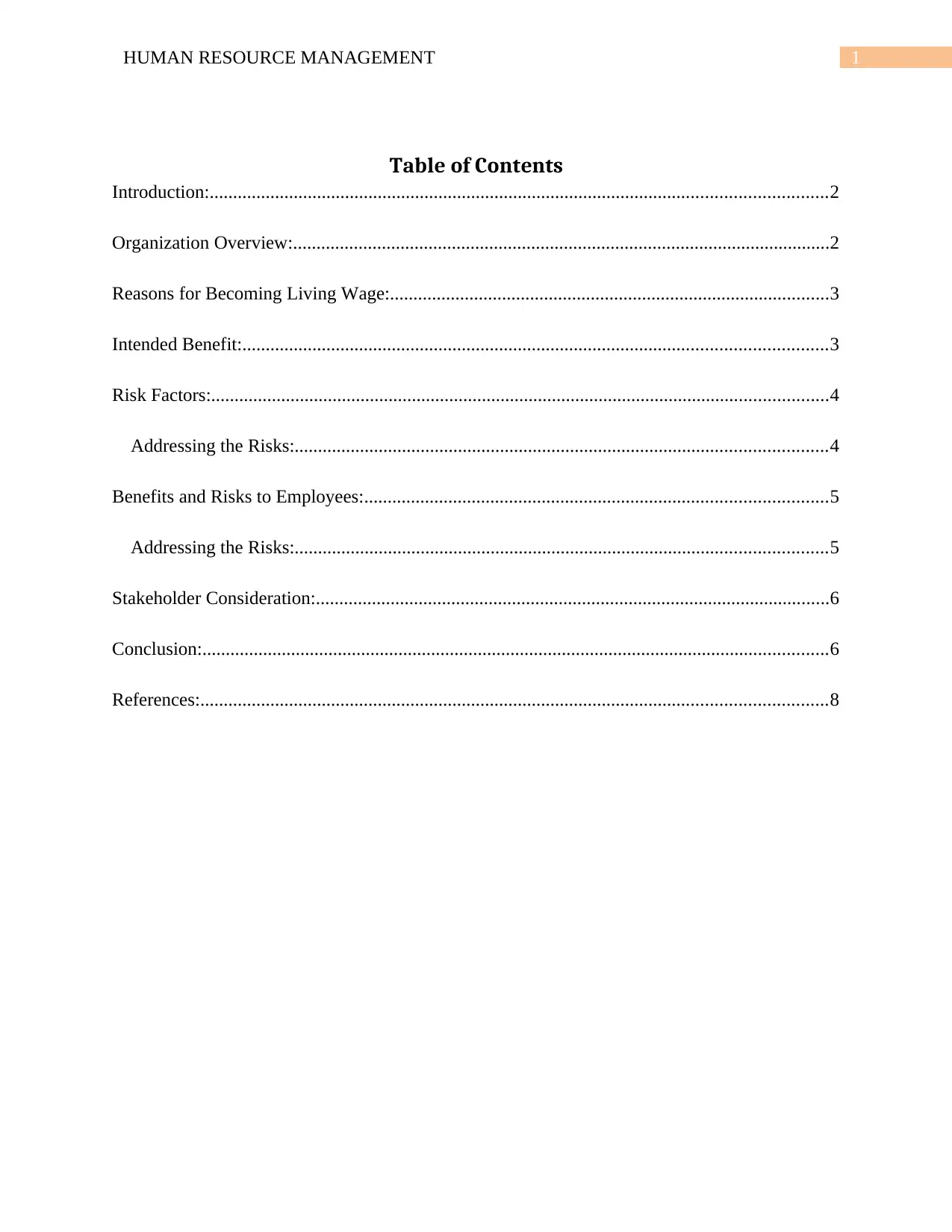
1HUMAN RESOURCE MANAGEMENT
Table of Contents
Introduction:....................................................................................................................................2
Organization Overview:...................................................................................................................2
Reasons for Becoming Living Wage:..............................................................................................3
Intended Benefit:.............................................................................................................................3
Risk Factors:....................................................................................................................................4
Addressing the Risks:..................................................................................................................4
Benefits and Risks to Employees:...................................................................................................5
Addressing the Risks:..................................................................................................................5
Stakeholder Consideration:..............................................................................................................6
Conclusion:......................................................................................................................................6
References:......................................................................................................................................8
Table of Contents
Introduction:....................................................................................................................................2
Organization Overview:...................................................................................................................2
Reasons for Becoming Living Wage:..............................................................................................3
Intended Benefit:.............................................................................................................................3
Risk Factors:....................................................................................................................................4
Addressing the Risks:..................................................................................................................4
Benefits and Risks to Employees:...................................................................................................5
Addressing the Risks:..................................................................................................................5
Stakeholder Consideration:..............................................................................................................6
Conclusion:......................................................................................................................................6
References:......................................................................................................................................8
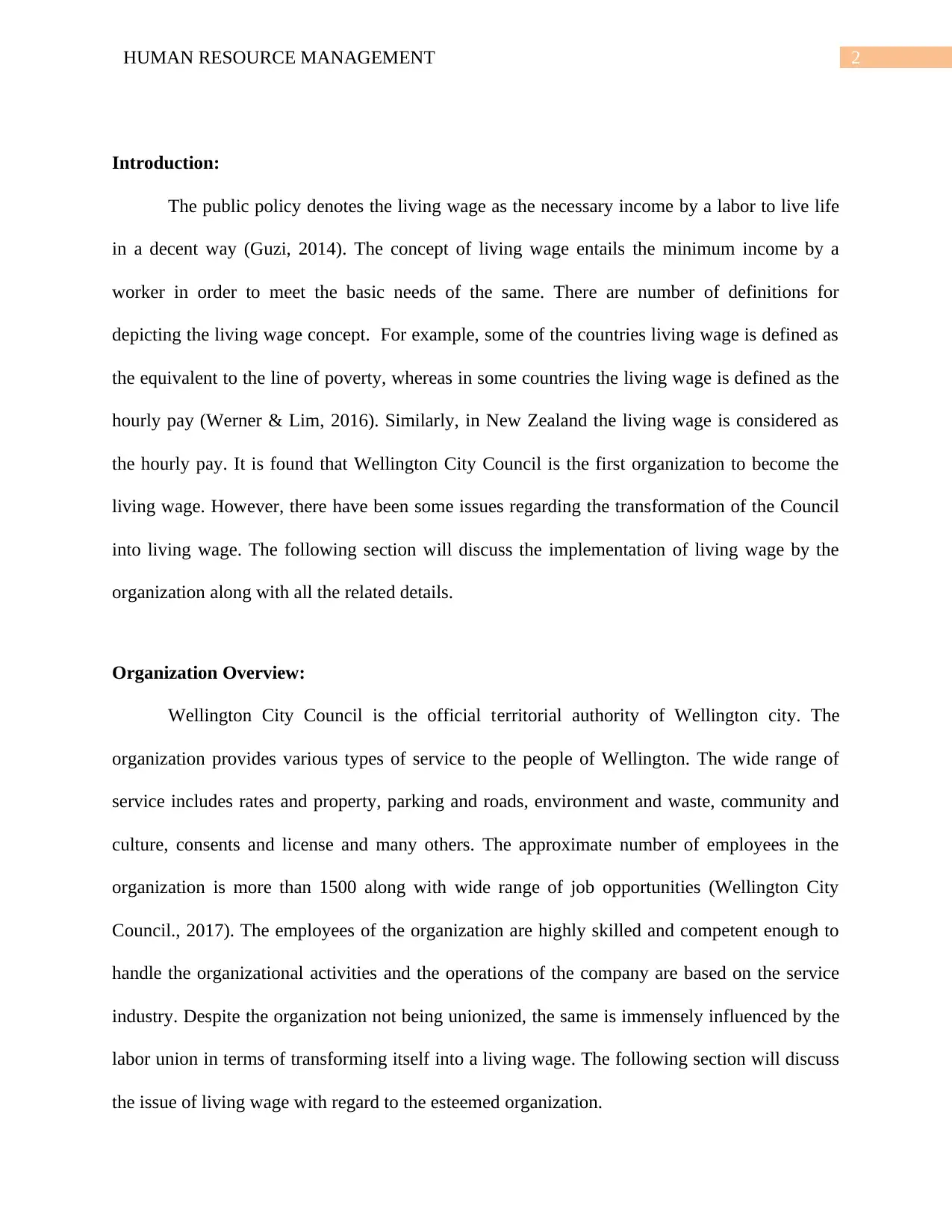
2HUMAN RESOURCE MANAGEMENT
Introduction:
The public policy denotes the living wage as the necessary income by a labor to live life
in a decent way (Guzi, 2014). The concept of living wage entails the minimum income by a
worker in order to meet the basic needs of the same. There are number of definitions for
depicting the living wage concept. For example, some of the countries living wage is defined as
the equivalent to the line of poverty, whereas in some countries the living wage is defined as the
hourly pay (Werner & Lim, 2016). Similarly, in New Zealand the living wage is considered as
the hourly pay. It is found that Wellington City Council is the first organization to become the
living wage. However, there have been some issues regarding the transformation of the Council
into living wage. The following section will discuss the implementation of living wage by the
organization along with all the related details.
Organization Overview:
Wellington City Council is the official territorial authority of Wellington city. The
organization provides various types of service to the people of Wellington. The wide range of
service includes rates and property, parking and roads, environment and waste, community and
culture, consents and license and many others. The approximate number of employees in the
organization is more than 1500 along with wide range of job opportunities (Wellington City
Council., 2017). The employees of the organization are highly skilled and competent enough to
handle the organizational activities and the operations of the company are based on the service
industry. Despite the organization not being unionized, the same is immensely influenced by the
labor union in terms of transforming itself into a living wage. The following section will discuss
the issue of living wage with regard to the esteemed organization.
Introduction:
The public policy denotes the living wage as the necessary income by a labor to live life
in a decent way (Guzi, 2014). The concept of living wage entails the minimum income by a
worker in order to meet the basic needs of the same. There are number of definitions for
depicting the living wage concept. For example, some of the countries living wage is defined as
the equivalent to the line of poverty, whereas in some countries the living wage is defined as the
hourly pay (Werner & Lim, 2016). Similarly, in New Zealand the living wage is considered as
the hourly pay. It is found that Wellington City Council is the first organization to become the
living wage. However, there have been some issues regarding the transformation of the Council
into living wage. The following section will discuss the implementation of living wage by the
organization along with all the related details.
Organization Overview:
Wellington City Council is the official territorial authority of Wellington city. The
organization provides various types of service to the people of Wellington. The wide range of
service includes rates and property, parking and roads, environment and waste, community and
culture, consents and license and many others. The approximate number of employees in the
organization is more than 1500 along with wide range of job opportunities (Wellington City
Council., 2017). The employees of the organization are highly skilled and competent enough to
handle the organizational activities and the operations of the company are based on the service
industry. Despite the organization not being unionized, the same is immensely influenced by the
labor union in terms of transforming itself into a living wage. The following section will discuss
the issue of living wage with regard to the esteemed organization.
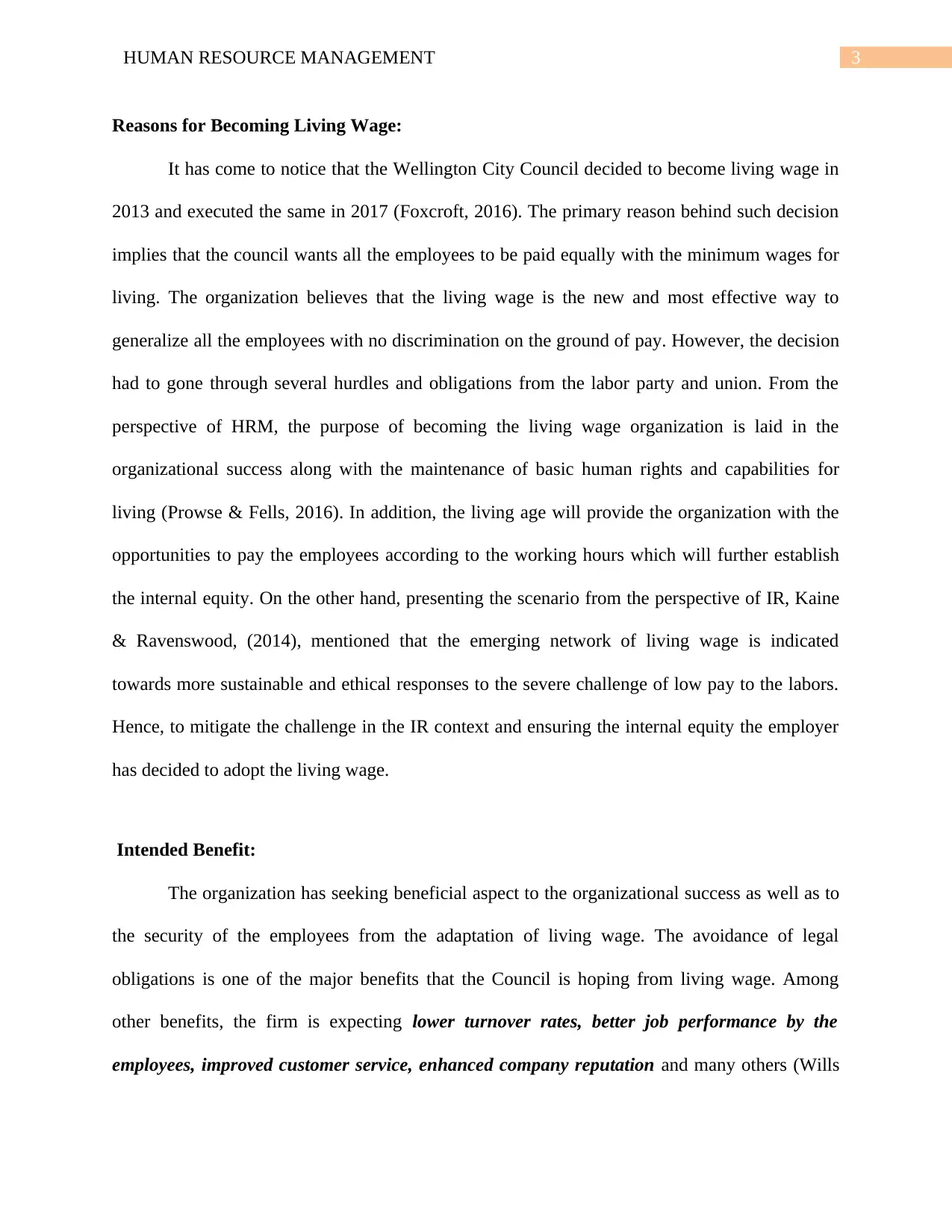
3HUMAN RESOURCE MANAGEMENT
Reasons for Becoming Living Wage:
It has come to notice that the Wellington City Council decided to become living wage in
2013 and executed the same in 2017 (Foxcroft, 2016). The primary reason behind such decision
implies that the council wants all the employees to be paid equally with the minimum wages for
living. The organization believes that the living wage is the new and most effective way to
generalize all the employees with no discrimination on the ground of pay. However, the decision
had to gone through several hurdles and obligations from the labor party and union. From the
perspective of HRM, the purpose of becoming the living wage organization is laid in the
organizational success along with the maintenance of basic human rights and capabilities for
living (Prowse & Fells, 2016). In addition, the living age will provide the organization with the
opportunities to pay the employees according to the working hours which will further establish
the internal equity. On the other hand, presenting the scenario from the perspective of IR, Kaine
& Ravenswood, (2014), mentioned that the emerging network of living wage is indicated
towards more sustainable and ethical responses to the severe challenge of low pay to the labors.
Hence, to mitigate the challenge in the IR context and ensuring the internal equity the employer
has decided to adopt the living wage.
Intended Benefit:
The organization has seeking beneficial aspect to the organizational success as well as to
the security of the employees from the adaptation of living wage. The avoidance of legal
obligations is one of the major benefits that the Council is hoping from living wage. Among
other benefits, the firm is expecting lower turnover rates, better job performance by the
employees, improved customer service, enhanced company reputation and many others (Wills
Reasons for Becoming Living Wage:
It has come to notice that the Wellington City Council decided to become living wage in
2013 and executed the same in 2017 (Foxcroft, 2016). The primary reason behind such decision
implies that the council wants all the employees to be paid equally with the minimum wages for
living. The organization believes that the living wage is the new and most effective way to
generalize all the employees with no discrimination on the ground of pay. However, the decision
had to gone through several hurdles and obligations from the labor party and union. From the
perspective of HRM, the purpose of becoming the living wage organization is laid in the
organizational success along with the maintenance of basic human rights and capabilities for
living (Prowse & Fells, 2016). In addition, the living age will provide the organization with the
opportunities to pay the employees according to the working hours which will further establish
the internal equity. On the other hand, presenting the scenario from the perspective of IR, Kaine
& Ravenswood, (2014), mentioned that the emerging network of living wage is indicated
towards more sustainable and ethical responses to the severe challenge of low pay to the labors.
Hence, to mitigate the challenge in the IR context and ensuring the internal equity the employer
has decided to adopt the living wage.
Intended Benefit:
The organization has seeking beneficial aspect to the organizational success as well as to
the security of the employees from the adaptation of living wage. The avoidance of legal
obligations is one of the major benefits that the Council is hoping from living wage. Among
other benefits, the firm is expecting lower turnover rates, better job performance by the
employees, improved customer service, enhanced company reputation and many others (Wills
Paraphrase This Document
Need a fresh take? Get an instant paraphrase of this document with our AI Paraphraser

4HUMAN RESOURCE MANAGEMENT
& Linneker, 2014). Apart from that, the Council believes that it can gain the trust of the
employees with the implementation of the living wage.
Risk Factors:
The initial risk of the organization lies in the adaptation of the living wage in terms
unionized activities of the external bodies. Local Government Act is creating obligations to the
organizations for paying equal as well as more than necessary to the employees on the basis of
work hours without corresponding benefits (Flint, Cummins & Wills, 2013). Providing all the
employees equal pay in terms of living wage can create conflicts between the organization and
the employees as some employees can obligate that the organization is paying more than
necessary pay to the staffs below them. On the other hand, the private limited companies can also
create hazard for the organization by countering the fact that the positions of the employees are
categorized on the basis of their eligibility which determine the pay. In addition, these private
employers can raise the fact that the cost of business is high for them which requires fair pay
based on competency and eligibility.
Addressing the Risks:
The organization must address the risks at the highest priority to avoid any hazards in
implementing the system. The risks from the union should be addressed by conducting face to
face meeting between the union and organization for mutual understanding of the issue as well as
the importance of the living wage. On the other side, the firm needs to have clear and thorough
understanding of the Local Government Act as well as the Employment Act in order to ensure
benefits from the implementation of the esteemed system. In order to avoid any conflicts with the
private companies the Council must publish its norms, procedures along with the legal
& Linneker, 2014). Apart from that, the Council believes that it can gain the trust of the
employees with the implementation of the living wage.
Risk Factors:
The initial risk of the organization lies in the adaptation of the living wage in terms
unionized activities of the external bodies. Local Government Act is creating obligations to the
organizations for paying equal as well as more than necessary to the employees on the basis of
work hours without corresponding benefits (Flint, Cummins & Wills, 2013). Providing all the
employees equal pay in terms of living wage can create conflicts between the organization and
the employees as some employees can obligate that the organization is paying more than
necessary pay to the staffs below them. On the other hand, the private limited companies can also
create hazard for the organization by countering the fact that the positions of the employees are
categorized on the basis of their eligibility which determine the pay. In addition, these private
employers can raise the fact that the cost of business is high for them which requires fair pay
based on competency and eligibility.
Addressing the Risks:
The organization must address the risks at the highest priority to avoid any hazards in
implementing the system. The risks from the union should be addressed by conducting face to
face meeting between the union and organization for mutual understanding of the issue as well as
the importance of the living wage. On the other side, the firm needs to have clear and thorough
understanding of the Local Government Act as well as the Employment Act in order to ensure
benefits from the implementation of the esteemed system. In order to avoid any conflicts with the
private companies the Council must publish its norms, procedures along with the legal

5HUMAN RESOURCE MANAGEMENT
considerations to the public through any press conference (Radio New Zealand., 2016). In
addition, the respective entity must make others aware of the importance of adopting the living
wage though various campaigning activities digital media.
Benefits and Risks to Employees:
However, the employees are not devoid of the benefits as well as the risks out of the
living wage implementation of the Wellington City Councils. Considering the fact of benefitting
the employees as the implementation of the living wage has been objectified by the Council, the
employees will be able to receive fair pay for their work. Exemplifying the employees living at
the poverty line will be benefitted from the system of living wage as the basic and minimum
income of them will be increased on the basis of their working hour. Countering this, the
employees at the higher level will be encountering risks as their hourly pay may reduce their
basic pay in terms of their eligibility. However, the conception of the living wage is for
benefitting the employees, the number of risks are less.
Addressing the Risks:
As stated before that the living wage conceptualizes the benefits to the employees the, the
risk factors are next to none. The only risk factor lies for the employees at the higher level,
whose minimum wages can be lowered due to the formulation of the living wage. Therefore, to
avoid the risks coming from the employees of higher level can be addressed by modifying the
living wage system. the modification must include the hourly pay on the basis of the eligibility
and not in general. The risk factor needs to be analyzed from both the employee and the
employer perspective in terms of the preventing any conflicts between the two.
considerations to the public through any press conference (Radio New Zealand., 2016). In
addition, the respective entity must make others aware of the importance of adopting the living
wage though various campaigning activities digital media.
Benefits and Risks to Employees:
However, the employees are not devoid of the benefits as well as the risks out of the
living wage implementation of the Wellington City Councils. Considering the fact of benefitting
the employees as the implementation of the living wage has been objectified by the Council, the
employees will be able to receive fair pay for their work. Exemplifying the employees living at
the poverty line will be benefitted from the system of living wage as the basic and minimum
income of them will be increased on the basis of their working hour. Countering this, the
employees at the higher level will be encountering risks as their hourly pay may reduce their
basic pay in terms of their eligibility. However, the conception of the living wage is for
benefitting the employees, the number of risks are less.
Addressing the Risks:
As stated before that the living wage conceptualizes the benefits to the employees the, the
risk factors are next to none. The only risk factor lies for the employees at the higher level,
whose minimum wages can be lowered due to the formulation of the living wage. Therefore, to
avoid the risks coming from the employees of higher level can be addressed by modifying the
living wage system. the modification must include the hourly pay on the basis of the eligibility
and not in general. The risk factor needs to be analyzed from both the employee and the
employer perspective in terms of the preventing any conflicts between the two.
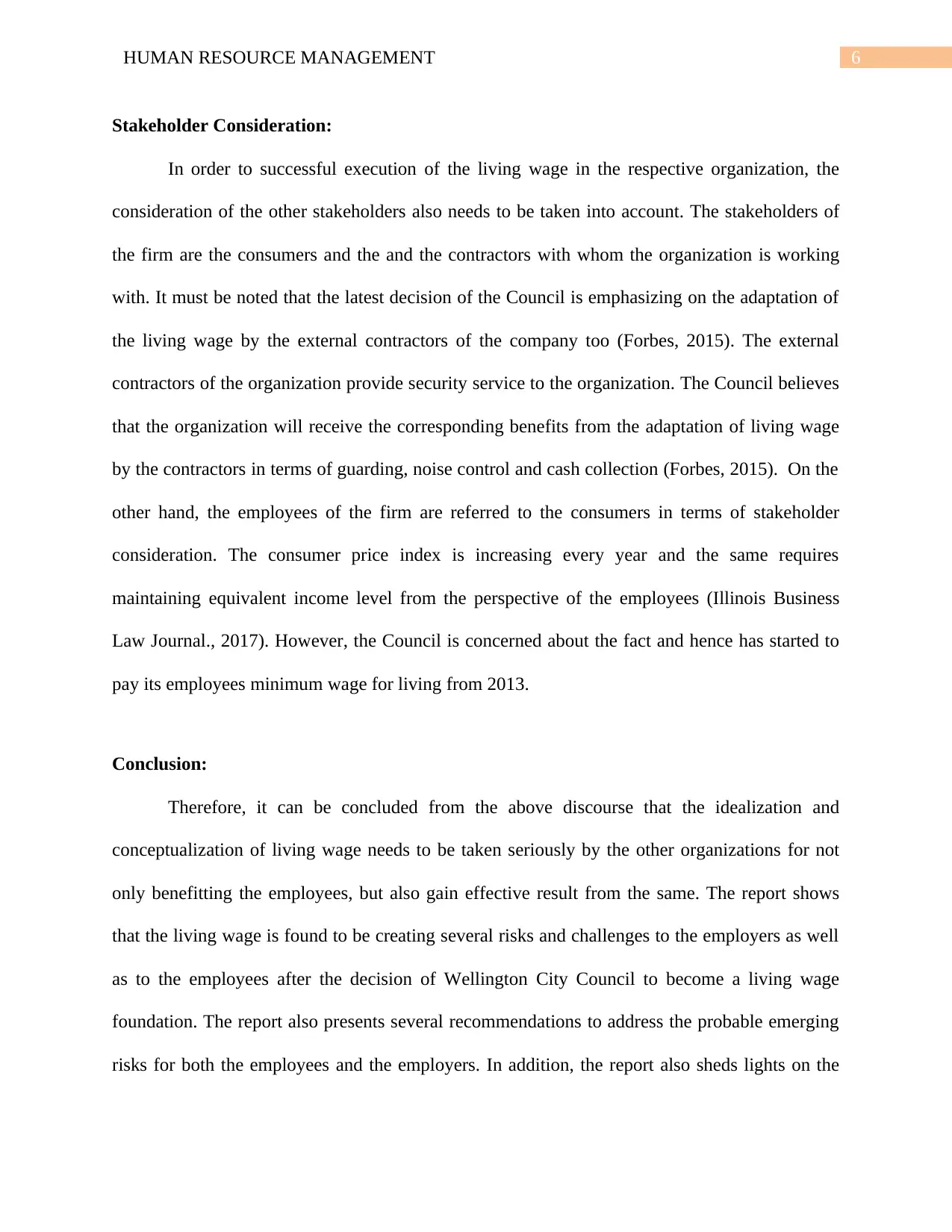
6HUMAN RESOURCE MANAGEMENT
Stakeholder Consideration:
In order to successful execution of the living wage in the respective organization, the
consideration of the other stakeholders also needs to be taken into account. The stakeholders of
the firm are the consumers and the and the contractors with whom the organization is working
with. It must be noted that the latest decision of the Council is emphasizing on the adaptation of
the living wage by the external contractors of the company too (Forbes, 2015). The external
contractors of the organization provide security service to the organization. The Council believes
that the organization will receive the corresponding benefits from the adaptation of living wage
by the contractors in terms of guarding, noise control and cash collection (Forbes, 2015). On the
other hand, the employees of the firm are referred to the consumers in terms of stakeholder
consideration. The consumer price index is increasing every year and the same requires
maintaining equivalent income level from the perspective of the employees (Illinois Business
Law Journal., 2017). However, the Council is concerned about the fact and hence has started to
pay its employees minimum wage for living from 2013.
Conclusion:
Therefore, it can be concluded from the above discourse that the idealization and
conceptualization of living wage needs to be taken seriously by the other organizations for not
only benefitting the employees, but also gain effective result from the same. The report shows
that the living wage is found to be creating several risks and challenges to the employers as well
as to the employees after the decision of Wellington City Council to become a living wage
foundation. The report also presents several recommendations to address the probable emerging
risks for both the employees and the employers. In addition, the report also sheds lights on the
Stakeholder Consideration:
In order to successful execution of the living wage in the respective organization, the
consideration of the other stakeholders also needs to be taken into account. The stakeholders of
the firm are the consumers and the and the contractors with whom the organization is working
with. It must be noted that the latest decision of the Council is emphasizing on the adaptation of
the living wage by the external contractors of the company too (Forbes, 2015). The external
contractors of the organization provide security service to the organization. The Council believes
that the organization will receive the corresponding benefits from the adaptation of living wage
by the contractors in terms of guarding, noise control and cash collection (Forbes, 2015). On the
other hand, the employees of the firm are referred to the consumers in terms of stakeholder
consideration. The consumer price index is increasing every year and the same requires
maintaining equivalent income level from the perspective of the employees (Illinois Business
Law Journal., 2017). However, the Council is concerned about the fact and hence has started to
pay its employees minimum wage for living from 2013.
Conclusion:
Therefore, it can be concluded from the above discourse that the idealization and
conceptualization of living wage needs to be taken seriously by the other organizations for not
only benefitting the employees, but also gain effective result from the same. The report shows
that the living wage is found to be creating several risks and challenges to the employers as well
as to the employees after the decision of Wellington City Council to become a living wage
foundation. The report also presents several recommendations to address the probable emerging
risks for both the employees and the employers. In addition, the report also sheds lights on the
Secure Best Marks with AI Grader
Need help grading? Try our AI Grader for instant feedback on your assignments.

7HUMAN RESOURCE MANAGEMENT
stakeholder consideration in regard to the necessity and successful implementation of living
wage by the esteemed organization.
stakeholder consideration in regard to the necessity and successful implementation of living
wage by the esteemed organization.

8HUMAN RESOURCE MANAGEMENT
References:
Flint, E., Cummins, S., & Wills, J. (2013). Investigating the effect of the London living wage on
the psychological wellbeing of low-wage service sector employees: a feasibility
study. Journal of Public Health, 36(2), 187-193.
Forbes, M. (2015). Wellington City Council pays more staff a living wage, costing ratepayers
$1.7m. Stuff. Retrieved 8 December 2017, from
http://www.stuff.co.nz/business/73450003/wellington-city-council-pays-more-staff-a-
living-wage-costing-ratepayers-24m
Foxcroft, L. (2016). Election results give green light to Living Wage councils. Living Wage
Movement Aotearoa NZ. Retrieved 8 December 2017, from
http://www.livingwage.org.nz/election_results_give_green_light_to_living_wage_counci
ls
Guzi, M. (2014). Estimating a living wage globally. Living out of stereotypes, 59.
Illinois Business Law Journal. (2017). Where to Open a Business: Consideration of Living Wage
Ordinances | Illinois Business Law Journal - University of Illinois at Urbana-Champaign.
Publish.illinois.edu. Retrieved 8 December 2017, from
https://publish.illinois.edu/illinoisblj/2006/09/26/where-to-open-a-business-
consideration-of-living-wage-ordinances/
Kaine, S., & Ravenswood, K. (2014). Working in residential aged care: A trans-Tasman
comparison. New Zealand Journal of Employment Relations (Online), 38(2), 33.
References:
Flint, E., Cummins, S., & Wills, J. (2013). Investigating the effect of the London living wage on
the psychological wellbeing of low-wage service sector employees: a feasibility
study. Journal of Public Health, 36(2), 187-193.
Forbes, M. (2015). Wellington City Council pays more staff a living wage, costing ratepayers
$1.7m. Stuff. Retrieved 8 December 2017, from
http://www.stuff.co.nz/business/73450003/wellington-city-council-pays-more-staff-a-
living-wage-costing-ratepayers-24m
Foxcroft, L. (2016). Election results give green light to Living Wage councils. Living Wage
Movement Aotearoa NZ. Retrieved 8 December 2017, from
http://www.livingwage.org.nz/election_results_give_green_light_to_living_wage_counci
ls
Guzi, M. (2014). Estimating a living wage globally. Living out of stereotypes, 59.
Illinois Business Law Journal. (2017). Where to Open a Business: Consideration of Living Wage
Ordinances | Illinois Business Law Journal - University of Illinois at Urbana-Champaign.
Publish.illinois.edu. Retrieved 8 December 2017, from
https://publish.illinois.edu/illinoisblj/2006/09/26/where-to-open-a-business-
consideration-of-living-wage-ordinances/
Kaine, S., & Ravenswood, K. (2014). Working in residential aged care: A trans-Tasman
comparison. New Zealand Journal of Employment Relations (Online), 38(2), 33.
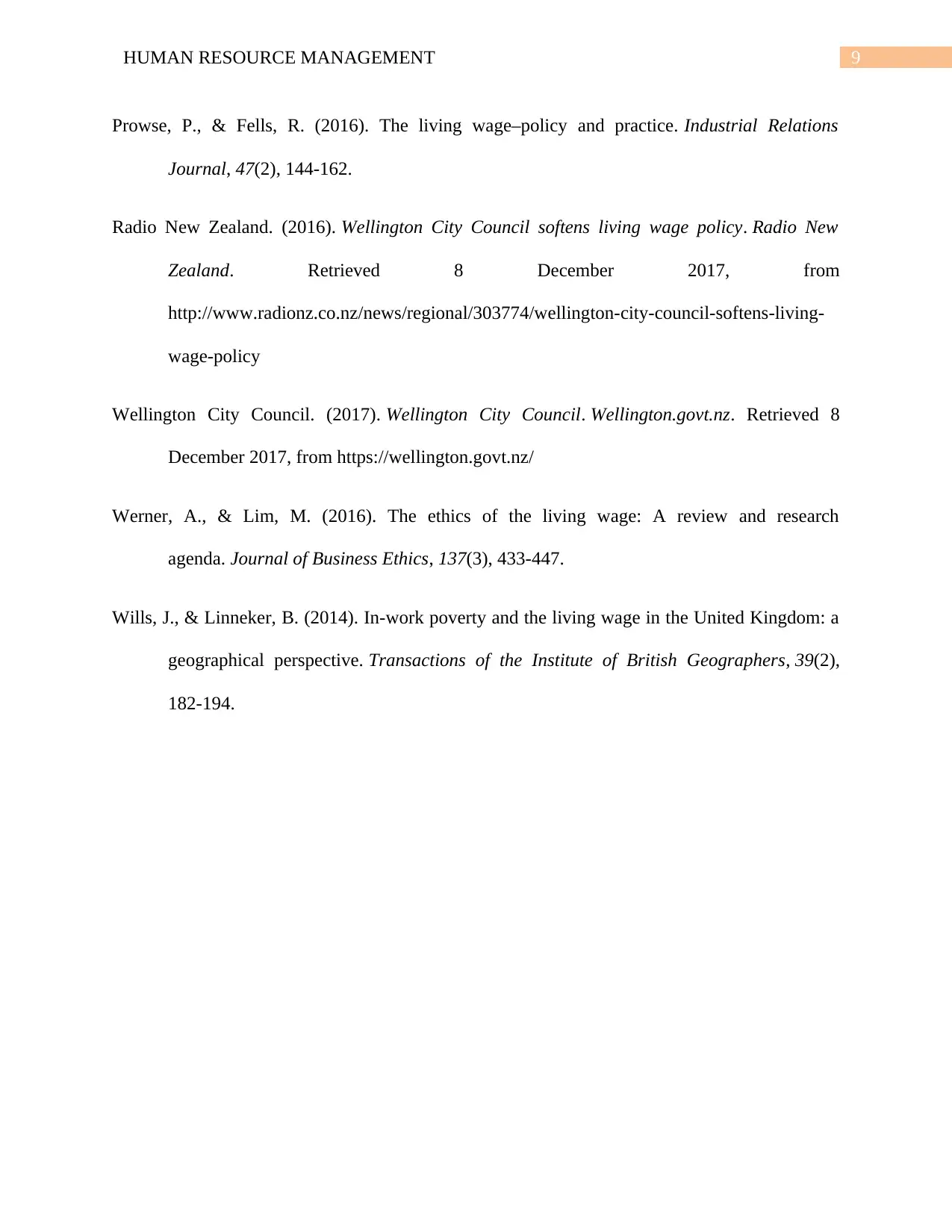
9HUMAN RESOURCE MANAGEMENT
Prowse, P., & Fells, R. (2016). The living wage–policy and practice. Industrial Relations
Journal, 47(2), 144-162.
Radio New Zealand. (2016). Wellington City Council softens living wage policy. Radio New
Zealand. Retrieved 8 December 2017, from
http://www.radionz.co.nz/news/regional/303774/wellington-city-council-softens-living-
wage-policy
Wellington City Council. (2017). Wellington City Council. Wellington.govt.nz. Retrieved 8
December 2017, from https://wellington.govt.nz/
Werner, A., & Lim, M. (2016). The ethics of the living wage: A review and research
agenda. Journal of Business Ethics, 137(3), 433-447.
Wills, J., & Linneker, B. (2014). In‐work poverty and the living wage in the United Kingdom: a
geographical perspective. Transactions of the Institute of British Geographers, 39(2),
182-194.
Prowse, P., & Fells, R. (2016). The living wage–policy and practice. Industrial Relations
Journal, 47(2), 144-162.
Radio New Zealand. (2016). Wellington City Council softens living wage policy. Radio New
Zealand. Retrieved 8 December 2017, from
http://www.radionz.co.nz/news/regional/303774/wellington-city-council-softens-living-
wage-policy
Wellington City Council. (2017). Wellington City Council. Wellington.govt.nz. Retrieved 8
December 2017, from https://wellington.govt.nz/
Werner, A., & Lim, M. (2016). The ethics of the living wage: A review and research
agenda. Journal of Business Ethics, 137(3), 433-447.
Wills, J., & Linneker, B. (2014). In‐work poverty and the living wage in the United Kingdom: a
geographical perspective. Transactions of the Institute of British Geographers, 39(2),
182-194.
1 out of 10
Related Documents
Your All-in-One AI-Powered Toolkit for Academic Success.
+13062052269
info@desklib.com
Available 24*7 on WhatsApp / Email
![[object Object]](/_next/static/media/star-bottom.7253800d.svg)
Unlock your academic potential
© 2024 | Zucol Services PVT LTD | All rights reserved.




